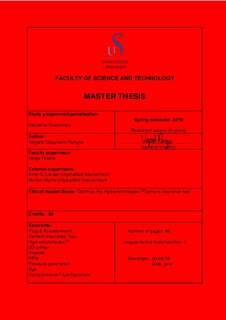| dc.contributor.advisor | Hodne, Helge | |
| dc.contributor.author | Rongve, Vegard | |
| dc.date.accessioned | 2018-10-04T07:36:16Z | |
| dc.date.available | 2018-10-04T07:36:16Z | |
| dc.date.issued | 2018-06 | |
| dc.identifier.uri | http://hdl.handle.net/11250/2566289 | |
| dc.description | Master's thesis in Industrial Economics | nb_NO |
| dc.description.abstract | The HydraArchimedesTM tool is called a cement insurance tool because of its ability to squeeze cement out through casing perforations by rotating the tool inside a casing, thereby creating a rock-to-rock barrier. It is therefore essential that the design of the tool is optimal to allow the tool to properly fill the annular space behind the casing with cement during a plug and abandonment (P&A) operation, thereby preventing oil and gas from migrating to the surface through holes and/or cracks in the cement plug.
This Master´s thesis builds on the Bachelor´s thesis called “Build and optimize a test-rig that can simulate the differential pressure produced by the HydraArchimedesTM during a P&A operation, as a function of angular velocity”, which was written by Vegard Rongve and Tor Kristian Opaas for HydraWell Intervention in 2016. The main purpose of the Bachelor´s thesis was to design and build a test-rig that could simulate a small-scale version of the situation in the well and also to analyze the pressure generated by the HydraArchimedesTM cement insurance tool during the operation. In the present Master´s thesis, the objective was to modify the test-rig and to examine different cement insurance tool designs in order to optimize HydraWell´s perforate-wash-cement technology (PWC). A 3D-printer was used to manufacture alternative plastic prototypes, and a pressure transmitter was used to record the pressure. Water containing dye and a computational fluid dynamics (CFD) analysis were then used to analyze the tool´s displacement effect on the water on the outside of the casing.
The results of this Master´s thesis indicate that the cement displacement efficiency of the current HydraArchimedesTM design can be increased. It appears the pressure generated by the current HydraArchimedesTM tool can be increased to provide better mixing and containment of the cement within its region of displacement in the well, whereby the tool will function as an effective restrictor in the well. The CFD-simulations indicated that the wiping effect from the tool´s rubber blades diverts the cement into the annulus due to its rotation. The testing indicated that Impeller 1, which has two blades threaded around its axis at a pitch ratio of 1.5, generates the largest amount of pressure and therefore functions as a very efficient restrictor in the well. Small-scale testing and CFD-simulation also indicated that the optimal cement displacement solution is obtained by connecting an axial flow impeller on top of the HydraArchimedesTM tool. | nb_NO |
| dc.language.iso | eng | nb_NO |
| dc.publisher | University of Stavanger, Norway | nb_NO |
| dc.relation.ispartofseries | Masteroppgave/UIS-TN-IØRP/2018; | |
| dc.subject | industriell økonomi | nb_NO |
| dc.subject | plug and abandonment | nb_NO |
| dc.subject | p&a | nb_NO |
| dc.title | Optimize the HydraArchimedes cement insurance tool | nb_NO |
| dc.type | Master thesis | nb_NO |
| dc.subject.nsi | VDP::Samfunnsvitenskap: 200::Økonomi: 210 | nb_NO |
